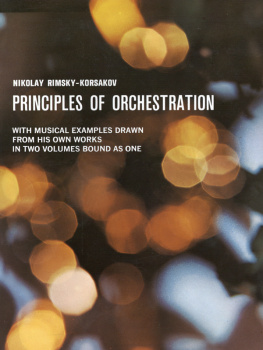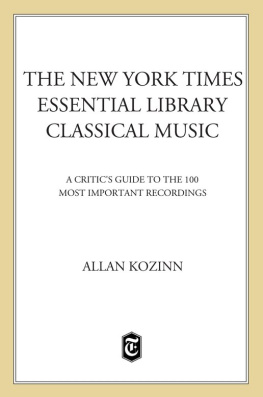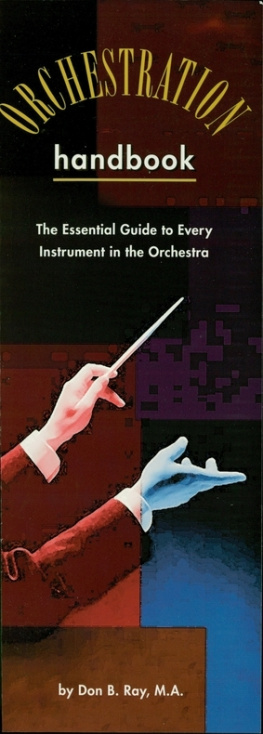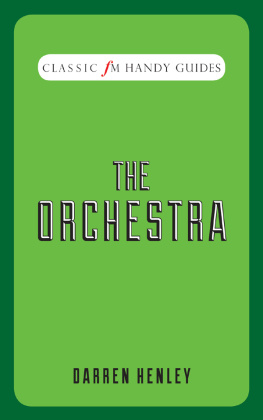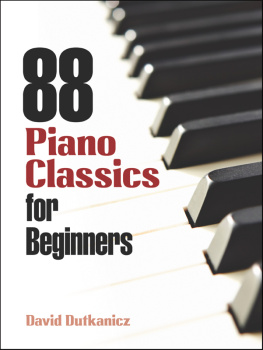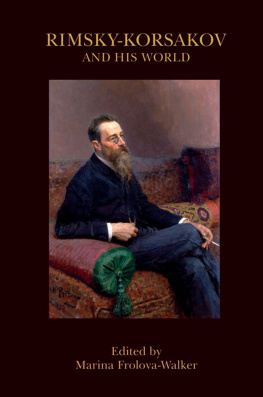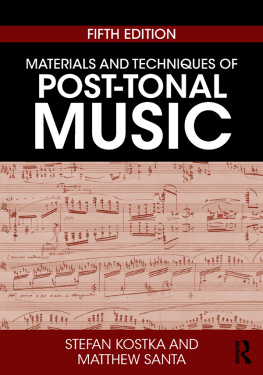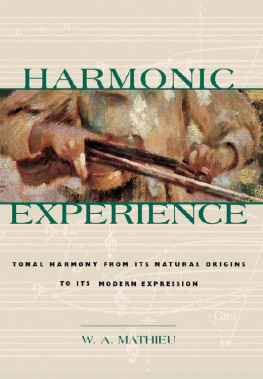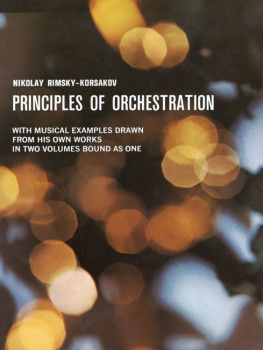Nikolay Rimsky-Korsakov - Principles of Orchestration
Here you can read online Nikolay Rimsky-Korsakov - Principles of Orchestration full text of the book (entire story) in english for free. Download pdf and epub, get meaning, cover and reviews about this ebook. year: 1964, publisher: Dover Publications, genre: Children. Description of the work, (preface) as well as reviews are available. Best literature library LitArk.com created for fans of good reading and offers a wide selection of genres:
Romance novel
Science fiction
Adventure
Detective
Science
History
Home and family
Prose
Art
Politics
Computer
Non-fiction
Religion
Business
Children
Humor
Choose a favorite category and find really read worthwhile books. Enjoy immersion in the world of imagination, feel the emotions of the characters or learn something new for yourself, make an fascinating discovery.
- Book:Principles of Orchestration
- Author:
- Publisher:Dover Publications
- Genre:
- Year:1964
- Rating:4 / 5
- Favourites:Add to favourites
- Your mark:
- 80
- 1
- 2
- 3
- 4
- 5
Principles of Orchestration: summary, description and annotation
We offer to read an annotation, description, summary or preface (depends on what the author of the book "Principles of Orchestration" wrote himself). If you haven't found the necessary information about the book — write in the comments, we will try to find it.
Principles of Orchestration — read online for free the complete book (whole text) full work
Below is the text of the book, divided by pages. System saving the place of the last page read, allows you to conveniently read the book "Principles of Orchestration" online for free, without having to search again every time where you left off. Put a bookmark, and you can go to the page where you finished reading at any time.
Font size:
Interval:
Bookmark:
This Dover edition, first published in 1964, is an unabridged and corrected republication of the work first published by Edition Russe de Musique in 1922. The first edition was issued in two separate volumes, whereas this Dover edition is complete in two volumes bound as one.
International Standard Book Number
ISBN-13: 978-0-486-21266-1
ISBN-10: 0-486-21266-1
Manufactured in the United States by Courier Corporation
21266122
www.doverpublications.com
Principles
of Orchestration
in two volumes bound as one
IText
______
______
Rimsky-Korsakov had long been engrossed in his treatise on orchestration. We have in our possession a thick note book of some 200 pages in fine hand writing, dating from the years 18731874, containing a monograph on the question of acoustics, a classification of wind instruments and a detailed description of the construction and fingering of the different kinds of flute, the oboe, clarinet and horn.
In his Memoirs of my musical life (1 st edition, p. 120) the following passage occurs: I had planned to devote all my energies to the compilation of a full treatise on orchestration. To this end I made several rough copies, jotting down explanatory notes detailing the technique of different instruments. What I intended to present to the world on this subject, was to include everything. The writing of this treatise, or, to be more exact, the sketch for it took up most of my time in the years 1873 and 1874. After reading the works of Tyndall and Helmholtz, I framed an introduction to my work, in which I endeavoured to expound the laws of acoustics as applied to the principles governing the construction of musical instruments. My manual was to begin with a detailed list of instruments, classified in groups and tabulated, including a description of the various systems in use at the present day. I had not yet thought of the second part of the book which was to be devoted to instruments in combination. But I soon realised that I had gone too far. With wind instruments in particular, the different systems were innumerable, and each manufacturer favoured his own pet theory. By the addition of a certain key the maker endowed his instrument with the possibility of a new trill, and made some difficult passages more playable than on an instrument of another kind.
There was no end to such complications. In the brass, I found instruments with three, four, and five valves, the mechanism varying according to the make. Obviously, I could not hope to cover so large a field; besides, of what value would such a treatise be to the student? Such a mass of detailed description of the various systems, their advantages and drawbacks, could not but fail to confuse the reader only too eager to learn. Naturally he would wish to know what instrument to employ, the extent of its capabilities etc., and getting no satisfactory information he would throw my massive work aside. For these reasons my interest in the book gradually waned, and finally I gave up the task.
In 1891 Rimsky-Korsakov, now an artist of standing, the composer of Snegourotchka, Mlada, and Shhrazade, a master of the orchestral technique he had been teaching for twenty years, returned to his handbook on instrumentation. He would seem to have made notes at different times from 1891 to 1893, during which period, after the first performance of Mlada, he gave up composition for a while. These notes, occasionally referred to in his Memoirs, are in three volumes of manuscript-paper. They contain the unfinished preface of 1891, a paragraph full of clear, thoughtful writing, and reprinted in this book.
As the author tells us in his Memoirs (p. 297), the progress of his work was hampered by certain troublesome events which were happening at the time. Dissatisfied with his rough draft, he destroyed the greater part of it, and once more abandoned his task.
In 1894 he composed The Christmas Night; this was the beginning of his most fertile period. He became entirely engrossed in composition, making plans for a fresh opera as soon as the one in hand was completed. It was not until 1905 that his thoughts returned to the treatise on orchestration, his musical output remaining in abeyance through no fault of his own. Since 1891 the plan of the work had been entirely remodelled, as proved by the rough drafts still extant. The author had given up the idea of describing different instruments from their technical standpoint, and was more anxious to dwell upon the value of tone qualities and their various combinations.
Among the authors papers several forms of the book have been found, each widely differing in detail from the other. At last, in the summer of 1905 Rimsky-Korsakov brought his plans to a head, and outlined the six chapters which form the foundation of the present volume. But the work suffered a further interruption, and the sketches were once more laid aside. In his Memoirs, Rimsky-Korsakov explains the fact by lack of interest in the work and a general feeling of weariness: The treatise remained in abeyance. To start with, the form of the book was not a success, and I awaited the production of Kitesh, in order to give some examples from that work (p. 360).
Then came the autumn of 1906. The composer experienced another rush of creative energy; his opera, The Golden Cockerel made rapid strides, and kept him busy all that winter and the following summer. When it was finished, in the autumn of 1907, his thoughts reverted to the treatise on orchestration. But the work made little progress. The author had his doubts as to the adequacy of the plan he had adopted, and, in spite of the entreaties of his pupils and friends, he could not bring himself to broach the latter part of the book. Towards the end of 1907 Rimsky-Korsakov was constantly ailing in health, and this materially affected his energy. He spent the greater part of his time reading old notes and classifying examples. About the 20 th of May he set out for his summer residence in Lioubensk, and having just recovered from a third severe attack of inflammation of the lungs, began to work on the first chapter of the treatise in its present, final form. This chapter was finished on June 7/20, about 4 oclock in the afternoon; the same night, the composer was seized with a fourth attack which proved fatal.
The honour fell on me to prepare this last work of Rimsky-Korsakov for publication. Now that Principles of Orchestration has appeared in print I think it necessary to devote a few words to the essential features of the book, and to the labour imposed upon me in my capacity as editor.
On the first point I will say but little. The reader will observe from the Contents that the work differs from others, not merely by reason of its musical examples, but more especially in the systematic arrangement of material, not according to orchestral division in groups (the method adopted by Gevaert for instance), but according to each constituent of the musical whole, considered separately. The orchestration of melodic and harmonic elements (). The last two chapters are devoted to operatic music, and the sixth takes a supplementary form, having no direct bearing on the previous matter.
Rimsky-Korsakov altered the title of his book several times, and his final choice was never made. The title I have selected seems to me to be the one most suitable to the contents of the work, principles in the truest sense of the word. Some may expect to find the secrets of the great orchestrator disclosed; but, as he himself reminds us in his preface, to orchestrate is to create, and this is something which cannot be taught.
Yet, as invention, in all art, is closely allied to technique, this book may reveal much to the student of instrumentation. Rimsky-Korsakov has often repeated the axiom that good orchestration means proper handling of parts. The simple use of tone-colours and their combinations may also be taught, but there the science of instruction ends. From these standpoints the present book will furnish the pupil with nearly everything he requires. The authors death prevented him from discussing a few questions, amongst which I would include full polyphonic orchestration and the scoring of melodic and harmonic designs. But these questions can be partly solved by the principles laid down in was completed by the author; it is published as it stands, save for a few unimportant alterations in style. As regards the other five chapters, I have tried to keep to the original drafts as far as possible, and have only made a few changes in the order, and one or two indispensable additions. The sketches made between 1891 and 1893 were too disconnected to be of much use, but, in point of fact, they corresponded very closely to the final form of the work.
Next pageFont size:
Interval:
Bookmark:
Similar books «Principles of Orchestration»
Look at similar books to Principles of Orchestration. We have selected literature similar in name and meaning in the hope of providing readers with more options to find new, interesting, not yet read works.
Discussion, reviews of the book Principles of Orchestration and just readers' own opinions. Leave your comments, write what you think about the work, its meaning or the main characters. Specify what exactly you liked and what you didn't like, and why you think so.

